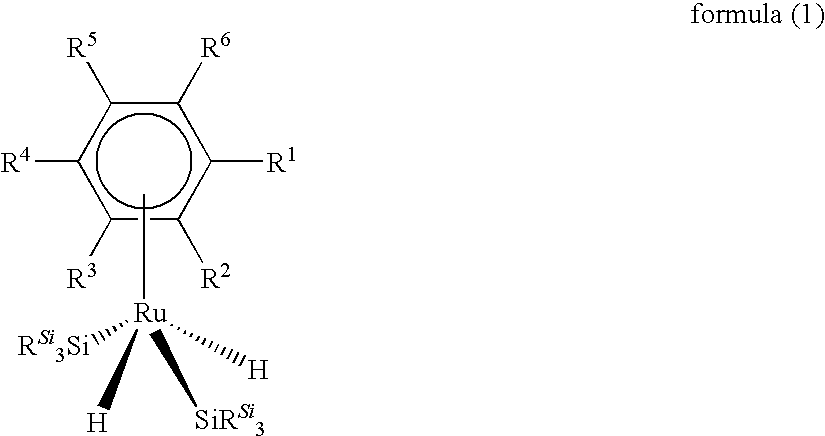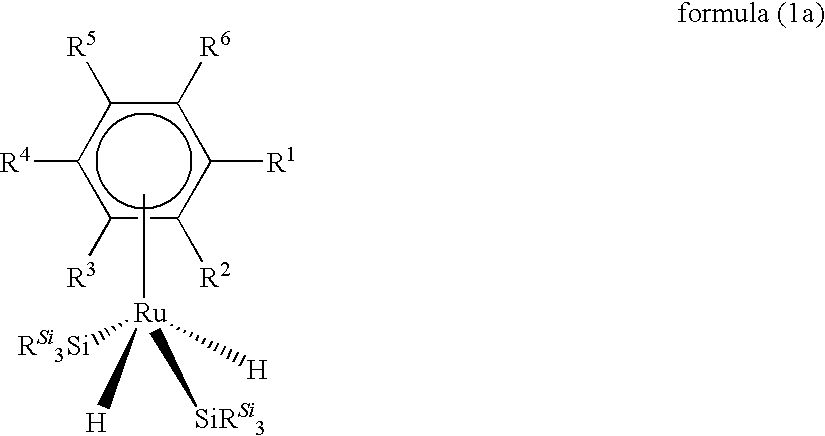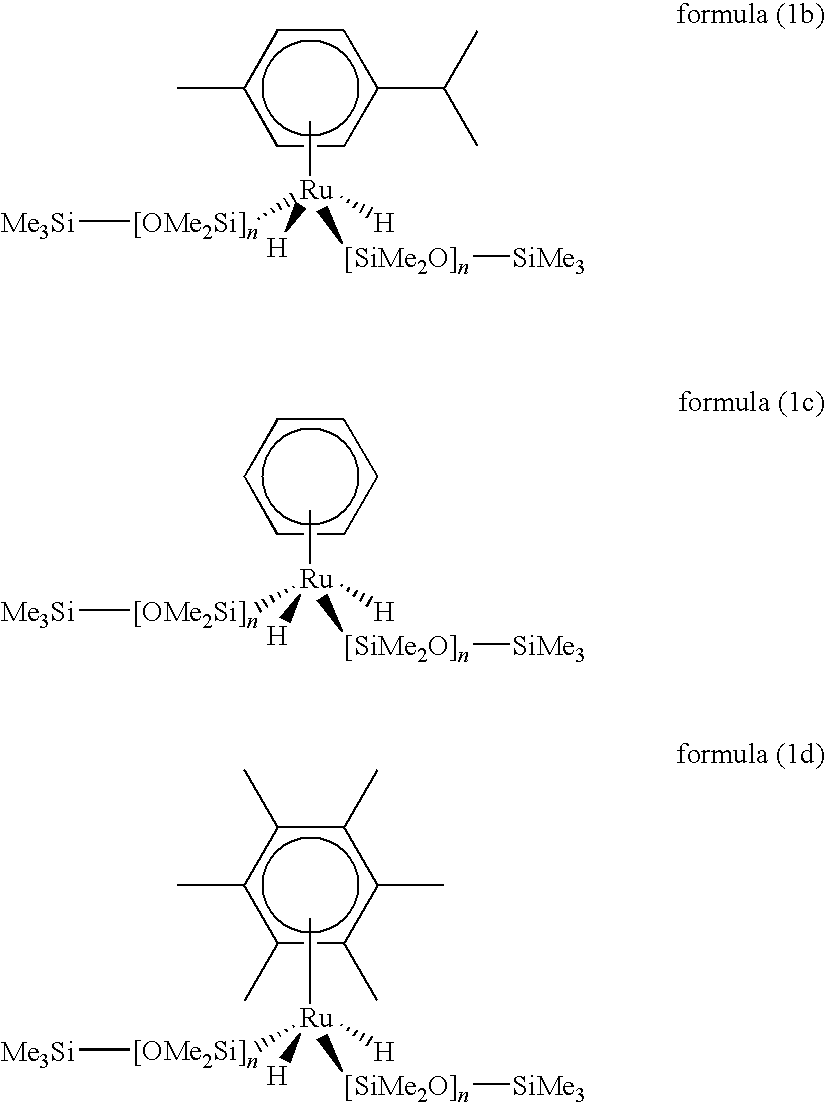Ru complexes, production and use thereof
a technology of complexes and silicophilic ligands, applied in the field of ru complexes, can solve the problems of insufficient rate and selectivity of non-pt catalysts described to date for hydrosilylation, distinctly inferior catalysts to common pt catalysts in regard to reactivity and selectivity, and high cost than for platinum, etc., to achieve good solubility in polysiloxanes and high similarity to siloxanes
- Summary
- Abstract
- Description
- Claims
- Application Information
AI Technical Summary
Benefits of technology
Problems solved by technology
Method used
Image
Examples
example 1
Synthesis of (p-cymene)Ru(H)2[(SiMe2O)xSiMe3]2 (x≈14)
[0141]
[0142]A mixture of 50 mg (0.08 mmol) of [(p-cymene)RuCl2]2 in 10 ml of tetrahydrofuran is admixed with 740 mg (approx. 0.67 mmol) of HMe2Si—[O—SiMe2]x—OSiMe3 and the mixture is heated to 80° C. for 15 h. After cooling, all volatile constituents are removed under reduced pressure. The residue is taken up in 20 ml of n-pentane and filtered through Florisil, and the filtrate is concentrated by evaporation under reduced pressure. There remains a brown oil. Yield 243 mg (62%).
[0143]1H NMR (300 MHz, C6D6): d=5.52 (s, br, 4H, C6H4), 2.44 [sept, 1H, CH(CH3)2], 2.01 (s, 3H, CH3), 1.11 [d, 6H, (CH3)2CH], 0.70 [s, 12H, (CH3)2Si—Ru], 0.24-0.17 [(CH3)2Si—O, SiMe3], −13.18 ppm (s, 2H, H—Ru).
example 2
Synthesis of (p-cymene)Ru(h4-TMDVS)
[0144]
[0145]A mixture of 995 mg (1.63 mmol) of [(p-cymene)RuCl2]2, 958 mg (9.03 mmol) of Na2CO3 (anhydrous) and 5.75 g (30.8 mmol) of divinyltetramethyldisiloxane in 50 ml of ethanol is heated under reflux at 90° C. for 4 h. After cooling, all volatile constituents are removed under reduced pressure. The residue is admixed with 50 ml of n-heptane, extracted at 40° C. for 1 h and filtered while warm through Celite in a preheated filter. The filtrate is concentrated to a volume of 5 ml and subjected to column chromatography using Al2O3 (neutral, activity level I, eluent: n-pentane). The evaporative concentration of the eluted yellow zone affords a yellow-orange oil. Yield: 346 mg (25%).
[0146]1H NMR (300 MHz, C6D6): d=4.39 (s, br, 4H, C6H4), 3.84-2.64 (m, 6H, H2C═CH—Si), 2.30 [sept, 1H, CH(CH3)2], 1.79 (s, 3H, CH3), 1.07 [d, 6H, (CH3)2CH], 0.46 (s, 6H, CH3Si), 0.38 ppm (s, 6H, CH3Si)
Study of the Catalytic Properties
example 3
Hydrosilylation of HMe2SiO—[SiMe2O]x—SiMe2H (x≈13) (H-polymer 13) with 3-vinylheptamethyltrisiloxane and the catalyst (p-cymene)Ru(H)2[(SiMe2O)x—SiMe3]2 (from Example 1) at 160° C.
[0147]A mixture of 2.5 g (approx. 2.63 mmol) of H-polymer 13 and 1.44 g (5.78 mmol) of 3-vinylheptamethyltrisiloxane is admixed with 28.4 mg of (p-cymene)Ru(H)2[(SiMe2O)x—SiMe3]2 (approx. 300 ppm of Ru) (obtainable by a process according to Example 1) and stirred at 160° C. The hydrosilylation reaction (conversion, selectivity, yield) is analyzed by 1H NMR.
[0148]
ReactionConversionSelectivityYieldtime[%][%][%] 15 min.8991811 h978987
PUM
| Property | Measurement | Unit |
|---|---|---|
| Fraction | aaaaa | aaaaa |
| Fraction | aaaaa | aaaaa |
| Fraction | aaaaa | aaaaa |
Abstract
Description
Claims
Application Information
 Login to view more
Login to view more - R&D Engineer
- R&D Manager
- IP Professional
- Industry Leading Data Capabilities
- Powerful AI technology
- Patent DNA Extraction
Browse by: Latest US Patents, China's latest patents, Technical Efficacy Thesaurus, Application Domain, Technology Topic.
© 2024 PatSnap. All rights reserved.Legal|Privacy policy|Modern Slavery Act Transparency Statement|Sitemap



